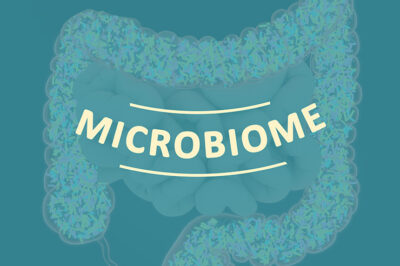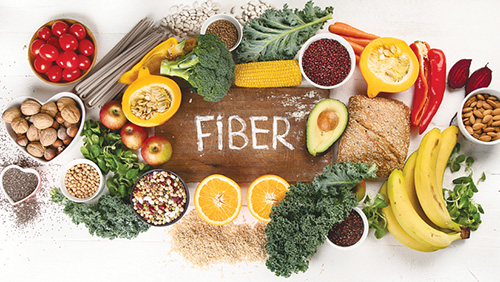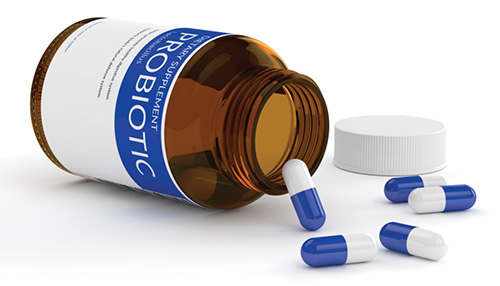From New Dawn 187 (Jul-Aug 2021)
The intestinal, or gut, flora of human beings plays a major role in the proper functioning of the body. As a vital link in the various stages of the digestive process, it synthesises nutrients, neutralises toxins, and so forth. It is such a fundamental element of our health that the body would be incapable of carrying on without it.
The intestinal flora (microbiome)is made of all the microorganisms living in the intestine. This population is extremely large. It is not counted in thousands but trillions. The human intestinal flora is composed of one hundred trillion microorganisms. It is about ten times the number of cells in the human body. If someone wished to gather all the intestinal microorganisms in a single container, this vessel would need to contain one to two litres. The weight of all these microorganisms would be anywhere from one to four kilograms. The ecosystem of the microbiota hosts more than four hundred different species of bacteria. But one single species of bacteria can include a large number of subgroups or serotypes. For example, the bacteria Escherichia coli (better known as E. coli) can be broken down into more than two hundred different serotypes, some of which produce a toxin but many of which are innocuous. The microorganisms that populate the intestines are tiny – roughly the size of a micron, which is 0.001 of a millimetre.
Intestinal microorganisms are not unwelcome guests that the body has to tolerate. On the contrary, their activity is beneficial to the body in a variety of ways. Although the contribution of each microorganism is minimal, the combined efforts of billions of them are extremely helpful (and necessary!) to the body. The microbiota supports the physical organism in many different ways.
The Functions of the Intestinal Flora
Its primary function is to help digestion. Before the cells of the body can benefit from the nutrients we eat, our foods must be broken down into particles that are small enough to cross through the intestinal walls and be transported by the blood to the cells. This preparatory work takes place during digestion. Although the digestive juices are capable of performing an immense part of this transformative work, they cannot do it all. Some of the nutrients in a food item can elude them.
Are the nutrients unaffected by digestion doomed to remain unused? No, the microorganisms of the intestine carry out the transformations that are still necessary. They produce enzymes that break down the fibres and framework of the tissues, and they reduce the volume of the large particles. Nutrients that are still highly useful will be released by this process: amino acids, carbohydrates, vitamins, and so forth. These final transformations of food are not performed by intestinal bacteria as a favour to their human hosts but for their own benefit. In fact, they also need to feed themselves to survive, and their food is the remnants of the foods we eat.
The digestive processes are carried out with the help of two major types of bacteria.
The bacteria of fermentation target the long carbohydrate chains, such as starch, but also the soft fibres of grains, fruits, vegetables, fruit peels, ribs of leafy plants, stringy parts of leek-like plants, and so on.
Bacteria of putrefaction break down any undigested particles of food that come their way. These are not fibres, having already been transformed by fermentation higher up in the intestines, but the residue of proteins (meats, fish, eggs) and starches (bread, pasta, rice).
The other functions of the intestinal flora are to:
- synthesise vitamins (of the B group);
- support the intestinal transit;
- destroy toxics;
- fight against inflammation;
- stimulate the production of lymphocytes;
- destroy pathogenic microbes.
Contribution to the Body’s Defence System: The Barrier Effect
A subtle balance is maintained with the size of the various populations of intestinal microorganisms, territories they occupy, the parts of the intestines they colonise, and the parts of foods to which they lay claim. Therefore, it is difficult for these invaders to establish themselves in the intestines and multiply because all the residential possibilities have already been exploited so fully. The living space they require in order to develop is unavailable and they lack nutrients. This is how, through its presence alone, the microbiota acts as a barrier against pathogenic bacteria. It prevents them from unleashing infections in the intestines or other parts of the body.
In the event there is an imbalance of the intestinal microorganisms, the barrier effect can be clearly insufficient. In this case, there is no obstacle to pathogenic bacteria establishing themselves and multiplying, which eventually leads to an infection. The destruction of bacteria is often the result of antibiotic treatments.
Enemies of the Intestinal Flora
Enemies of the intestinal flora are factors that sharply reduce the population of microorganisms and thus compromise our health. The bacteria that are most often affected are generally those of fermentation that populate the small intestine and the beginning of the colon. The bacteria of putrefaction that live in the terminus of the colon are much less affected. The two main enemies are:
A Lack of Fibres
The food required by the bacteria of fermentation in our intestinal flora is the fibre in our human diet. It should be noted that fibre is a choice food for the bacteria of fermentation and not for those of putrefaction.
If the bacteria of fermentation receive adequate fibre, they will be healthy and strong, and they will multiply easily. When fibre intake is low, on the other hand, the number of bacteria of fermentation in the intestinal flora will also shrink. In fact, the quantity of food always determines the size of the population that depends on it. Small quantities of fibre can feed only a small number of bacteria, so the population of bacteria of fermentation will shrink. The diminished population will be weakened.
The three dietary fibres that are the preferred foods of the flora of fermentation are all of plant origin: mucilaginous substances (found in, for example, okra and flax seeds), pectins (found in, for example, apples and guavas), and oligosaccharides (found in legumes, nuts, and so on).
Consequently, individuals who do not eat enough of these plant foods have a deficiency of fibre. This is common in diets that are poor in salad greens, raw and cooked vegetables, nuts (almonds, hazelnuts), and whole grains. Foods that are high in fibre should be eaten several times a day.
The importance of fibre for the fermentation flora stems from the fact that this flora depends entirely on the fibres from food to work and survive. An intake of sufficient fibre is therefore a key factor in the health of the intestinal flora and consequently our overall health.
Antibiotics
They are among the most often prescribed medications. Their role is to kill living organisms that attack the body, but they don’t necessarily discriminate. The living organisms they target are pathogenic microbes, but in the process antibiotics also kill other microorganisms. There are more than one hundred types of antibiotics, and some cause more damage to the intestinal flora than others, and in different ways.
Some antibiotics are able to kill a number of different kinds of disease-causing bacteria; they are known as broad-spectrum antibiotics because of the range of their activity. Other antibiotics have an effect on only one kind of bacteria or another, and they are known as narrow-spectrum antibiotics. The length of the treatment is another factor. During a short course, some microorganisms that could be vulnerable may escape damage due to the limited time they are in contact with the antibiotic. Conversely, during a longer period of treatment, contact is prolonged. The antibiotic is more thorough and effective, but it also destroys many intestinal microorganisms. The same happens when the patient undergoes several antibiotic treatments.
Diseases Caused by Imbalance
The problems caused by an imbalance of the intestinal flora are numerous. Some take place at the intestinal level: indigestion, gas, bloating, diarrhea and constipation. General disorders are infections, inflammations, food allergies, autoimmune diseases, some mental disorders, and weight gain.
How to Restore Your Intestinal Flora
Two different complementary approaches are used to rebuild the flora of fermentation. The first approach consists of feeding the bacteria of fermentation by consuming foods that are high in fibre, also called prebiotics. However, this slow process shows results only after a certain period of time. If there is a pressing need to make change quickly, proceed to the second approach. This approach consists of implanting a large number of fermentation bacteria from outside the body into the intestines. This is done by means of probiotics, meaning foods or special preparations that contain a multitude of these bacteria. Instead of waiting for the bacteria that are present to multiply, this approach brings a large number directly into the body from outside. This increases the population and allows it to gradually return to its normal size.
Feeding with Prebiotics
Prebiotics are dietary substances that come in the form of plant fibre that cannot be digested by human beings but can be digested by the fermentation bacteria. The two main sources are fruits and vegetables.
All fruits provide prebiotics that are useful for our intestinal flora. These fruits can all be consumed fresh to enjoy their benefits, but they are just as helpful when dried. Dried fruits include dates, figs, raisins, apricots, prunes, mangoes, and many more. Fruits can be eaten as snacks and desserts.
Vegetables can be eaten raw in the form of green salad, crudités (including shredded carrots or celery, or sliced tomatoes or cucumbers), mixed salad (salad greens combined with a variety of raw vegetables), juiced with pulp, or as vegetable sticks (carrots, cucumbers, peppers, turnip, with dip); cooked to taste; or simmered in homemade vegetable soup.
Fruits and vegetables must be eaten in generous quantities, several times a day and every day.
This process might appear to be too simple, but it is the most effective!
Prebiotic Supplements
A number of prebiotic supplements are available commercially. The fibres they contain are no different from the fibre contained in foods. In theory, these supplements are unnecessary, as simply eating enough prebiotic foods should supply the bacteria of fermentation with all the food they need. However, in practice, they have been proven to be quite helpful. This is particularly true for those with sensitive intestines that become easily irritated by high fibre content, which then becomes an obstacle to eating as much fibre as they need.
Repopulating Bacteria
The regular ingestion of prebiotic fibres makes it possible to maintain a large and healthy population of flora of fermentation, and to correct any minimal, inevitable reductions in the size of its population. On the other hand, if the flora of fermentation population has been severely weakened, these maintenance procedures will not suffice. More drastic measures are required to make up for the deficit. At this critical point, the intestinal flora has been decimated, and it is necessary to rapidly increase the number of bacteria in residence. In these circumstances, reconstruction of the intestinal flora is achieved by importing fermentation bacteria from outside the body to add numbers to the ones already present in the intestines.
These bacteria can be consumed in two different forms. Each has its benefits, and using them together is beneficial.
- Foods that have high probiotic content, such as yogurt (bifidus), kefir, fresh and fermented cheeses, sauerkraut, fermented vegetables, and miso;
- Probiotic supplements manufactured in a laboratory.
Probiotic Supplements
Probiotic supplements are the greatest help to quickly restore a decimated intestinal flora population, for example, by antibiotics. Probiotic supplements can supply as many as 550 billion bacteria per gel cap. This supply is therefore of a completely different order from that offered by foods with probiotic properties. Yogurt, for example, generally contains a maximum of one billion bacteria per serving. Probiotic supplements are therapy, whereas probiotic foods are still in the dietary domain. However, foods are much more effective over the long term. The bacteria contained in probiotic supplements are primarily lactic bacteria of the Bifidobacterium and Lactobacillus. These strains are strongly represented in the flora of fermentation, but other kinds of bacteria are also used.
Because all the bacteria used for manufacturing probiotic supplements have been freeze-dried, they are in the form of a dry powder. It is only when these bacteria are in the warm and moist environment of our intestines that they become active again.
Who Should Take a Probiotic Cure?
People who most need a probiotic cure are those who suffer from:
- Recurring digestive problems: diarrhea, indigestion, irritable bowel syndrome, constipation, and so forth;
- Repeated infections: fungal infections, cystitis, colds, and so on;
- Allergies;
- Side effects of antibiotics;
- Psychological problems: anxiety, depression, and so forth.
All probiotic supplements share the same goal of rebuilding the intestinal flora of fermentation. In the past, reconstruction of this flora was the sole objective for taking supplements. A better understanding of the properties of the different strains has now expanded the range of activity for these preparations. Depending on their composition, they can have an additional complimentary therapeutic action for the following: diarrhea, digestive weakness, constipation, irritable bowel, fungal infections, travel abroad, immune system weakness, weight loss.
How Do I Take Probiotics?
Instructions are provided by the product’s manufacturer. But, as a general rule, probiotics are taken before meals when the stomach is empty so they make their way into the intestines more quickly. Cures will last from one week to several months. Following a course of treatment, it is a good idea to solidify the results by continuing to take one to two doses a week for a period of two to three months. The same amount is also recommended for a preventative dose. If you find after a month that the corrective is not doing its job, it could be that the bacteria in the preparation you are taking are not the bacteria you need. In this case, you should switch to another probiotic supplement.
There are no side effects from taking probiotics. At the very most, some extra-sensitive individuals might start feeling one of the following symptoms: minor stomach discomfort, gas, bloating, or constipation. The speed with which the effects start to appear depends on the degree of the initial health problem. While the impact of countering some conditions – for example, infectious diarrhea (gastroenteritis) – begin to show up in just a few hours, it usually takes at least a week to feel any improvement from well-established disorders. But these will be only the first signs of improvement. A full cure usually takes several weeks or even a month, depending on the individual case.
Conclusion
A strong and balanced intestinal flora does not depend on remedies or sophisticated treatments but primarily on a healthy lifestyle. This is a parameter we can work within easily. It doesn’t take high-priced supplements or expensive therapies, only simple adjustments to our daily diet. The foods that balance our intestinal flora are far from the most expensive. It’s up to us to make smart and healthy choices about what goes into our grocery baskets and consequently into our bodies.
A full rundown can be found in Christopher Vasey’s book Restoring Your Intestinal Flora in which he explains how to restore your microbiome. The book is available from all good bookstores.
© New Dawn Magazine and the respective author.
For our reproduction notice, click here.





